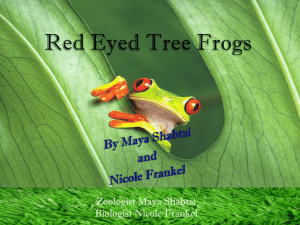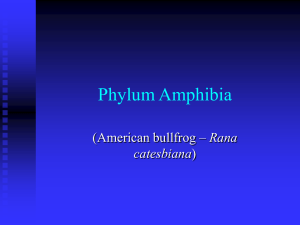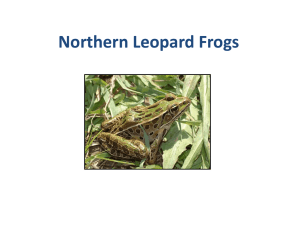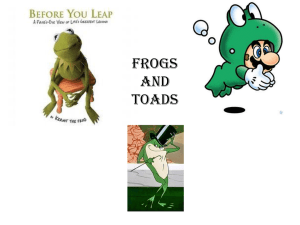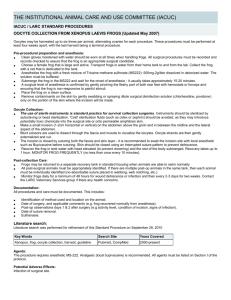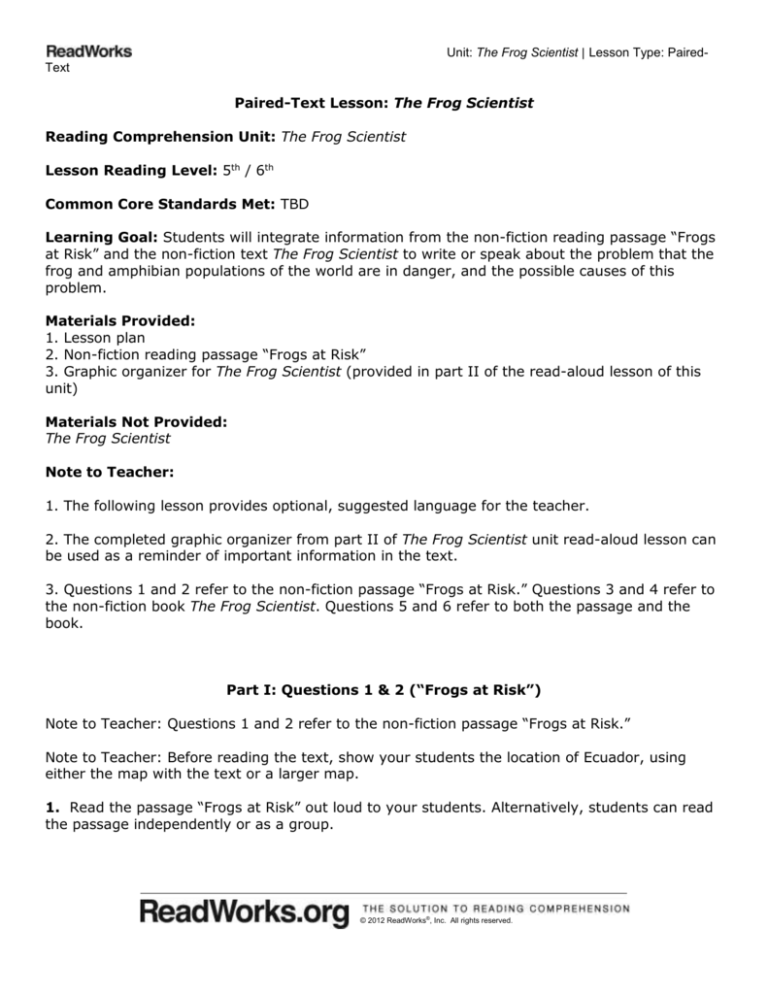
Unit: The Frog Scientist | Lesson Type: PairedText
Paired-Text Lesson: The Frog Scientist
Reading Comprehension Unit: The Frog Scientist
Lesson Reading Level: 5th / 6th
Common Core Standards Met: TBD
Learning Goal: Students will integrate information from the non-fiction reading passage “Frogs
at Risk” and the non-fiction text The Frog Scientist to write or speak about the problem that the
frog and amphibian populations of the world are in danger, and the possible causes of this
problem.
Materials Provided:
1. Lesson plan
2. Non-fiction reading passage “Frogs at Risk”
3. Graphic organizer for The Frog Scientist (provided in part II of the read-aloud lesson of this
unit)
Materials Not Provided:
The Frog Scientist
Note to Teacher:
1. The following lesson provides optional, suggested language for the teacher.
2. The completed graphic organizer from part II of The Frog Scientist unit read-aloud lesson can
be used as a reminder of important information in the text.
3. Questions 1 and 2 refer to the non-fiction passage “Frogs at Risk.” Questions 3 and 4 refer to
the non-fiction book The Frog Scientist. Questions 5 and 6 refer to both the passage and the
book.
Part I: Questions 1 & 2 (“Frogs at Risk”)
Note to Teacher: Questions 1 and 2 refer to the non-fiction passage “Frogs at Risk.”
Note to Teacher: Before reading the text, show your students the location of Ecuador, using
either the map with the text or a larger map.
1. Read the passage “Frogs at Risk” out loud to your students. Alternatively, students can read
the passage independently or as a group.
© 2012 ReadWorks®, Inc. All rights reserved.
Unit: The Frog Scientist | Lesson Type: PairedText
2. Teacher asks students question 1: “According to the text, what problem is occurring for frogs
in Ecuador and for amphibians in North and South America?”
Suggested student response: “The problem that is occurring in Ecuador is that the frog
population is in danger. Many types of frogs and toads are at risk of becoming extinct, and
eight types of frogs have in fact become extinct during the past 100 years. The problem
that is occurring for amphibians in North and South America is similar. Many amphibians
in North and South America have become extinct, and two out of every five species is in
danger.”
3. Teacher asks students question 2: “What do scientists believe is the cause of this problem of
possible extinction?”
Suggested student response: “Scientists believe that there are several causes. One cause
is that the amphibians are losing their habitat, or where they live. Another cause is that
the animals are getting sick. There are also changes in the weather and pollution that
scientists believe have caused the decline in populations of amphibians.”
Part II: Questions 3 & 4 (The Frog Scientist)
Note to Teacher: Questions 3 and 4 refer to the non-fiction book The Frog Scientist.
4. Teacher asks students question 3: “What was Tyrone Hayes trying to find out with his
experiment on the frogs from Dugway Pond?”
Suggested student response: “Tyrone was trying to find out how the pesticide atrazine
affects frogs. He has done experiments that show that male frogs exposed to atrazine
make eggs instead of sperm and therefore cannot have baby frogs. He is trying to prove
that atrazine is one cause of the fact that the numbers of many species of frogs are
declining around the world.”
5. Teacher asks students question 4: “So what result does Tyrone hope to have from his
experiment?”
Suggested student response: “Tyrone hopes to help save the millions of frogs that are in
danger. He also wants to remind people that if there is something in the environment that
is affecting frogs, it may be affecting humans, too.”
Part III: Questions 5 & 6 (“Frogs at Risk” and The Frog Scientist)
Note to Teacher: Questions 5 and 6 refer to both the passage and the book.
6. Teacher asks students question 5: “How might Tyrone’s experiment help other scientists
understand what is happening to amphibian populations in North and South America?”
© 2012 ReadWorks®, Inc. All rights reserved.
Unit: The Frog Scientist | Lesson Type: PairedText
Suggested student response: “If Tyrone’s experiment (conducted in Wyoming and
California, both located in North America) shows that the pesticide atrazine creates
deformities in male frogs so that they cannot reproduce, it might help other scientists to
better understand why some frog populations that have been similarly exposed to
pesticides might be decreasing.”
7. Teacher states out loud: “So both texts talk about the problem that the population of
amphibians, especially frogs, is decreasing, and both texts point to at least one reason why this
might be happening.
Let’s look again at the last section of the non-fiction passage “Frogs at Risk.” This part of the
passage states that scientists are fighting to save amphibians and that some scientists want
governments to pass laws to help frogs.”
8. Teacher asks students question 6: “How is Tyrone part of the fight to save amphibians?”
Suggested student response: Answers will vary and could include:
“Tyrone is trying to show that a pesticide is harming frogs. If he can prove this, it would
give more evidence that could help scientists in the fight to save amphibians. Using
evidence from Tyrone’s experiment, scientists could try to persuade governments to pass
laws that would require farmers to use pesticides that do not hurt amphibians or other
animals, and this could help save frogs and other amphibians.”
© 2012 ReadWorks®, Inc. All rights reserved.





